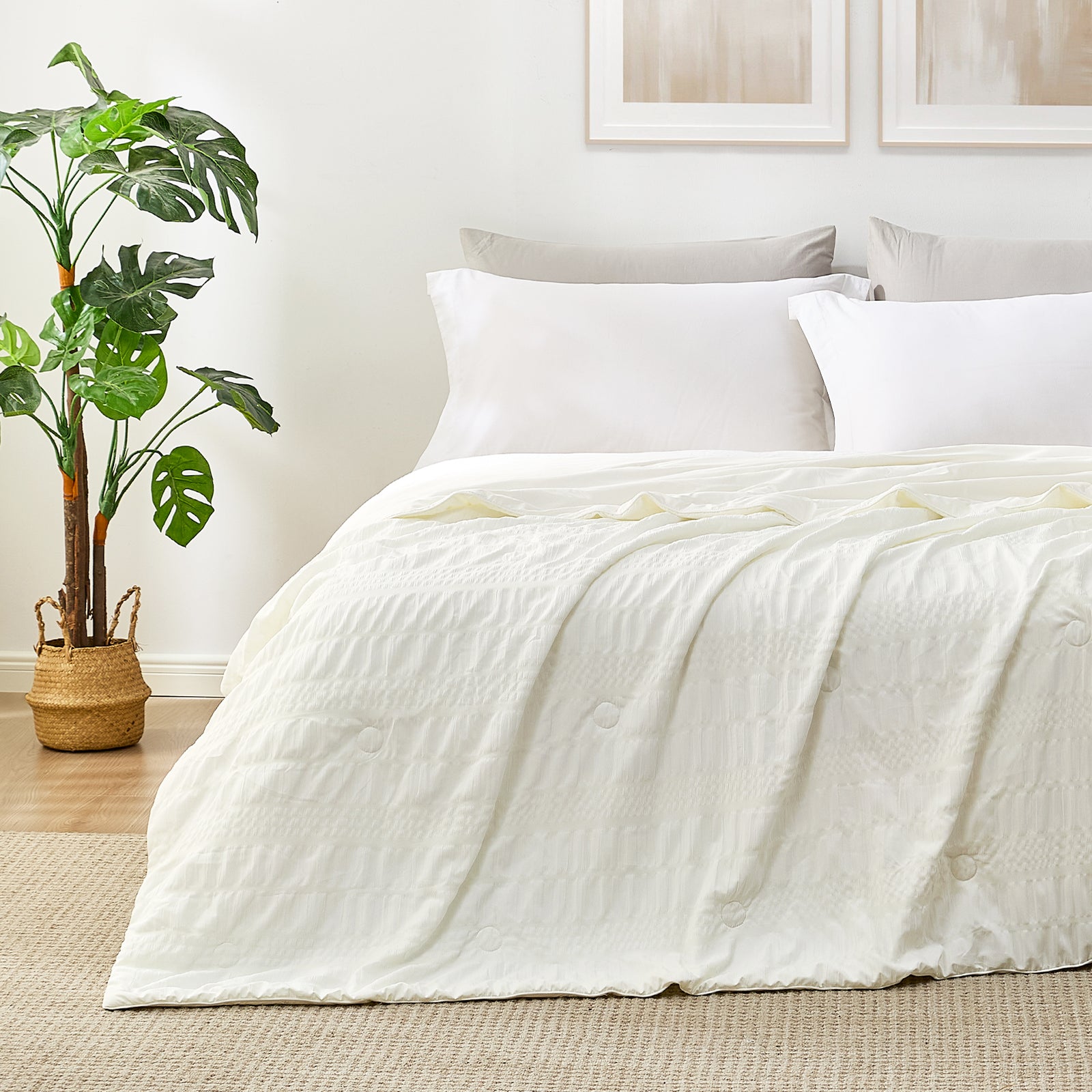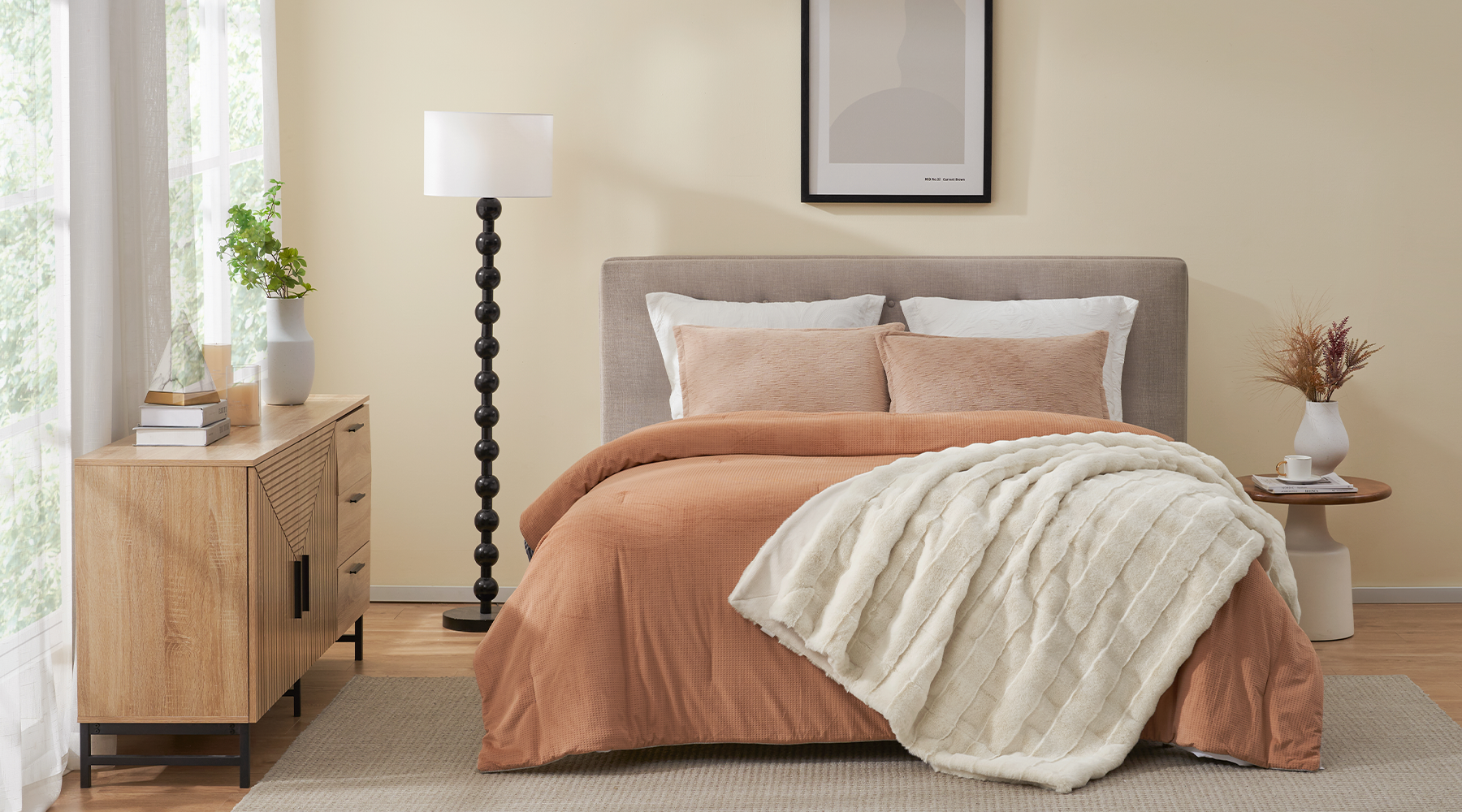Putting a soft blanket around yourself can make you feel better. Throw blankets are smaller and can be used for more things than the blankets on your bed. They are easy to grab when you need extra warmth while sitting on the couch. They can also make a room look better by adding comfort to chairs. You can use a throw blanket for more than just staying warm. They can also be used to decorate and protect your furniture from damage. This article talks about the most common materials used to make throw blankets, as well as their sizes, how to clean them, and how to pick the right one for you.
Why Throw Blankets are Essential Home Accessories?
These seemingly simple textiles offer a surprising number of benefits, making them indispensable additions to almost any home.
- Extra Warmth When You Need It: Throw blankets are easy to grab when you feel chilly on a cool evening or in an air-conditioned room. They're lighter than bed blankets but still warm enough for watching TV or reading.
- They Look Good: Throw blankets add color, pattern, and texture to your furniture. They're an affordable way to refresh your room's look with the changing seasons.
- They're Easy to Move Around: Their smaller size makes them handy for different uses. Put them on sofas or chairs, at the foot of your bed, take them outside on cool evenings, bring them when traveling, or even hang a nice one on your wall.
- They Protect Your Furniture: A throw blanket can shield your couch or chair from spills, pet hair, and daily wear, helping your furniture last longer.
- They Make Spaces Feel Cozier: Putting a throw blanket on a chair or part of the sofa creates a spot that feels meant for relaxing.
- They Make Great Gifts: Practical and available in many styles and prices, throw blankets are gifts that most people appreciate for housewarming, holidays, or birthdays.

Throw Blanket Types: Popular Materials & Weaves
The heart of a throw blanket lies in its material. The fiber content dictates nearly everything: how soft it feels against your skin, its level of warmth and weight, breathability, visual appearance, long-term durability, care requirements, and ultimately, its cost.
Popular Natural Fibers
Natural fibers are derived from plants or animals and often prized for their inherent qualities.
Cotton
Characteristics: Cotton is known for its softness, breathability, and hypoallergenic properties, making it suitable for sensitive skin. It generally holds up well to machine washing. Its breathability makes it a good choice for year-round use or in warmer climates where heavy insulation isn't needed.
Common Weaves: You'll find cotton throws in various weaves, including simple plain weaves, textured waffle weaves, classic cable knits, and patterned herringbone designs.
Pros: Relatively easy care, breathable, versatile for different seasons, widely available.
Cons: Might not provide sufficient warmth for very cold conditions compared to wool or thick fleece, can wrinkle easily depending on the weave.
Wool
Characteristics: Wool is renowned for its exceptional warmth and insulation. It's naturally durable, moisture-wicking (pulling moisture away from the body), and possesses some natural flame resistance.
Variations: The feel of wool varies greatly. Standard wool can sometimes feel scratchy, while finer grades like Merino wool are significantly softer. Cashmere, from goats, is incredibly luxurious, ultra-soft, and lightweight yet warm. Lambswool is also generally softer than standard wool.
Pros: Excellent warmth-to-weight ratio, highly durable, classic aesthetic, moisture-wicking.
Cons: Can feel itchy depending on the grade, usually requires special care (hand washing or dry cleaning), often carries a higher price tag, especially for Merino or Cashmere.
Popular Synthetic Fibers
Synthetic fibers are man-made and often engineered to offer specific properties like softness, durability, or affordability.
Fleece (Polyester)
Characteristics: Fleece is exceptionally soft, lightweight, and surprisingly warm for its weight. Made from polyester, it's durable, hydrophobic (meaning it resists absorbing water and dries quickly), and typically very affordable.
Variations: Common types include standard fleece, Microfleece (thinner, denser pile), Sherpa (which features a plush, fluffy backing mimicking sheepskin on one side and smooth fleece on the other), and ultra-plush or Minky fabrics known for their silky softness. These various fleeces are commonly used to make warm fleece blankets that are not heavy.
Pros: Very soft and cozy feel, provides good warmth, usually machine washable and dries quickly, budget-friendly.
Cons: Less breathable than natural fibers like cotton or wool, can sometimes generate static electricity, lower quality fleece may pill (form small balls of fiber) over time.
Acrylic
Characteristics: Acrylic fibers are often used to mimic the feel and insulating properties of wool. It's lightweight, generally soft, holds vibrant colors well, and is usually more affordable than wool.
Pros: Offers a wool-like appearance and warmth at a lower cost, good color retention, often machine washable.
Cons: Less breathable than wool, prone to pilling with friction and washing, can also generate static.
Faux Fur (Polyester/Acrylic blend)
Characteristics: Designed to replicate the look and feel of animal fur, faux fur throws are typically made from polyester or acrylic blends. They offer high loft, exceptional softness, a luxurious appearance, and considerable warmth. Faux fur blankets stand out among synthetic options for their luxurious feel and visual appeal that elevates any room's decor.
Pros: High visual impact, very soft and indulgent texture, provides significant coziness.
Cons: Requires gentle care – often spot clean or machine wash on a delicate cycle and always air dry (heat can melt the fibers). Can be prone to shedding, especially lower-quality versions. Quality and realism vary significantly.
Blended Fibers
Manufacturers often blend different fibers to leverage the advantages of each. For example, a Cotton-Polyester blend might aim for the breathability of cotton combined with the durability and wrinkle-resistance of polyester. Wool-Acrylic blends might offer warmth similar to wool but with easier care and a lower price point. Always check the label for the specific fiber content to gauge the likely characteristics.
Throw Blanket Sizes: Finding the Right Fit
While throws vary, there are common dimensions to be aware of. The size affects not only how much coverage it provides but also how it drapes visually and its suitability for different applications.
Most Common Standard Size: 50 inches x 60 inches
This is overwhelmingly the most typical size for a throw blanket. It's large enough to comfortably cover one adult sitting or lounging, drapes nicely over most sofas and chairs without being overwhelming, and works well folded at the foot of a Twin or Full bed. Its versatility makes it the go-to standard.
Other Common Sizes
- Smaller Sizes: You might find throws around 40" x 50". These are often suitable for children, as purely decorative accents on smaller chairs, or for use as lap blankets.
- Larger Sizes: Throws measuring 60" x 70" or even 60" x 80" offer more generous coverage. These are better options if you plan on sharing the throw, prefer ample fabric to wrap up in, want a more substantial look on a large sofa, or intend to use it across the foot of a Queen or King-sized bed.
4 Considerations for Choosing Size
- Intended Use: Will it primarily cover one person on a chair, or do you need it large enough for two on a sofa? Is it mainly for decoration, or maximum warmth coverage? Will it live at the foot of your bed?
- Furniture Scale: A tiny throw might look lost on a large sectional sofa, while an oversized throw could dwarf a small armchair. Aim for proportionality.
- Desired Drape: Consider how much fabric you want hanging over the edges of the furniture for aesthetic purposes.
- Personal Preference: Some people simply prefer the feeling of being enveloped in a larger blanket.
Adorn Your Space with the Ideal Throw Blankets!
Throw blankets are essential for making your home warm and stylish because they look great and are useful at the same time. Understanding the differences between materials, such as the differences between warm wool, soft fleece, and luxurious fake fur, as well as the differences in sizes, will help you make a smart choice. Now that you know these things, you can confidently weigh your choices and bring home the perfect throw blanket to make your living space look better and make those relaxing moments even better.





Leave a comment
This site is protected by hCaptcha and the hCaptcha Privacy Policy and Terms of Service apply.